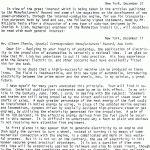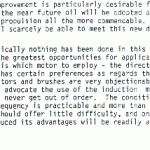Nicola Tesla’s View of the Future in Motive Power
特斯拉使用多相感应电动机提高上面的信件,以提高电动汽车的效率。他的电动车很可能是他在1930年代建造的,利用了他的多相感应电动机之一。根据他的助理Authur Matthews的第一手账户,由Tesla发明的辅助Authur Matthews的电源是一个用于为汽车供电的独特的主要电池。这种电池是独一无二的,它具有可更换的锌电极。当锌用完时,它被简单地更换。该系统将需要直流电转换器。
特斯拉states that he made numerous statements in publications in regards to using electricity to power a car. Tracking down these statements should dispel the myth that his car was powered by radiant energy.
Manufacturers’ Record
Dec. 29, 1904, p. 583
ELECTRIC AUTOS
Nikola Tesla’s View of the Future in Motive Power
(特殊的Cor.。Manufacturers’ Record)
New York, December 27
In view of the great interest which is being taken in the articles published by the Manufacturers’ Record and some of the magazines on the development of new power-producers, through the internal-combusion engine, for use for transportation purposes both by land and sea, the following signed statement, made by Mr. Nikola Tesla after a discussion of a new type of auto-bus designed by Mr. Charles A. Lieb, mechanical engineer of the Manhattan Transit Co., will doubtless be read with much general interest:
New York, December 17
纽约特别通讯州特别通讯制造商纪录:
Dear Sir – Replying to your inquiry of yesterday, the application of electricity to the propulsion of automobiles is certainly a rational idea. I am glad to know that Mr. Lieb has undertaken to put it into practice. His long experience with the General Electric Co. and other concerns must have excellently fitted him for the task.
There is no doubt that a highly-successful machine can be produced on these lines. The field is inexhaustible, and this new type of automobile, introducing electricity between the prime mover and the wheels, has, in my opinion, a great future.
我拥有多年来倡导这一原则。您的会在我发表此效果的众多技术出版物陈述中找到。在我19世纪的世纪文献中,我说,在处理这个主题:蒸汽船和火车仍然被直接施加蒸汽功率到轴或轴。通过使用由特别设计的高压蒸汽或燃气发动机驱动的采用的海洋发动机和机车,通过使用产生的电力,可以通过代替采用的海洋发动机和机车来改变燃料的热能的更大百分比。推进。在源自燃料的有效能量中,可以获得50至100%的增益,可以以这种方式确保。很难理解为什么一个如此平原和显而易见的事实并没有得到更多从工程师的关注。
乍一看,可能似乎通过发动机产生电力,然后施加电流以转动轮,而不是通过与发动机的一些机械连接来转动它,是一种复杂且更浪费的过程。但它不是那么;相反,以这种方式使用电力确保了很大的实际优势。这是一个问题,这一问题是这种想法将广泛应用于铁路,也是海上衬垫,虽然在后一种情况下,条件并不是那么有利。铁路公司如何持续使用普通机车是一个谜。通过提供发动机发电并与当前电动机运行,火车可以以更大的速度推进,更经济地。在法国,这已经由黑士曼完成,虽然他的机器不是最好的,但他获得的结果是可信和令人鼓舞的。我计算出速度和经济的显着增益也可以在海洋衬垫中固定,因为许多原因,改善是特别理想的。很可能在近期未来的油将被用作燃料,这将使新的推进方法更加值得称道。电气制造公司几乎没有能够满足这种对发电机和电机的新需求。
In automobiles practically nothing has been done in this direction, and yet it would seem they offer the greatest opportunities for application of this principle. The question, however, is which motor to employ – the direct-current or my induction motor. The former has certain preferences as regards the starting and regulation, but the commutators and brushes are very objectionable on an automobile. In view of this I would advocate the use of the induction motor as an ideally simple machine which can never get out of order. The conditions are excellent, in as much as a very low frequency is practicable and more than three phases can be used. The regulation should offer little difficulty, and once an automobile on this novel plan is produced its advantages will be readily appreciated.
Yours very truly,
N. Tesla.











